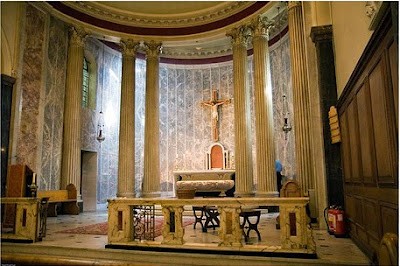Looking back – looking forward
2020 is a milestone year in the life of this Parish as we celebrate 200 years of mission and ministry in the City of London. We are using this moment to thank God for all that has brought us to where we are today, and to commit the next 200 years of our Parish and City to His bountiful care. Read on to find out more of our story.
History
The roots of the parish of St Mary Moorfields go back to several chapels that sprang up in the area in the seventeenth and eighteenth centuries.
Catholic worship in those days was illegal.
The chapels were known locally as ‘Penny Hotels’, as people had to pay a penny to a man behind a grill in the door before they were allowed in.
These were hard times for Catholics. In 1736, for example, the Gordon Rioters attacked the chapel in Ropemakers Alley, ripping out its altar, fittings and crucifixes. Following the Catholic Relief Act of 1791, Catholics were permitted to worship in public. And in 1820 the first church of St Mary Moorfields opened in Finsbury Circus. As the permanent seat of the Vicar Apostolic, it served as Cardinal Wiseman’s pro-cathedral from 1850 to 1869.
The church was pulled down in 1899 and replaced by the present church in Eldon Street, which was opened on 25th March 1903. The architect was George Sherrin, who also designed the dome of the London Oratory as well as several Underground stations.
An Architect Looks Back in History
This foundation has a long and proud history. A chapel was opened in 1686, but had to be suspended in 1689. From 1736 there was a chapel in Ropemaker’s Alley, whose fabric and furniture were destroyed in the Gordon Riots. This was succeeded by a chapel in White Street. Its replacement in 1820 by a large Classical church in Finsbury Square sponsored by laypeople marked a turning point in the size and stylistic aspirations of Catholic churches. Its architect John Newman entertained the notion of concealing the source of light for the altar-piece, and journeyed on the Continent in search of examples. He found the example he required in Paris in the church of St Sulpice, which confirmed his intention of using the idea. The plan consisted of nave, aisles and apsidal sanctuary. The glory of the church, however, was the altar-piece concealed from view. On the terminal wall was a fresco of Mount Calvary executed by Angelo Aglio, 55ft high and 33ft wide, containing over fifty principal figures. Its scale may be envisaged from the dimensions of the cross alone, which was 18 ft high. This final church of the first wave of building that succeeded in the 1791 Catholic Relief Act was probably the finest in structure and decoration. As the permanent seat of the Vicar Apostolic, it served as Cardinal Wiseman’s pro-cathedral from 1850 to 1869.
That part of the city having become less of a residential centre, this illustrious church was pulled down in 1899 and replaced by the present church in Eldon Street, which was opened on 25th March 1903. The builders were Holliday and Greenwood, and Cardinal Vaughan’s chosen architect was George Sherrin, already known for the completion of the London Oratory dome, and such works as colleges, houses and underground stations.
Sherrin clearly did the best he could to provide a church that need not be compared unfavourably with its predecessor, whilst battling against the difficulties of a restricted side and ancient lights. The front to Eldon Street is flanked by shops and allowed no display of a conventional church façade. The most that Sherrin could provide here was an arched entrance of Portland stone with Quattrocento detailing, surmounted by a group of sculptures by J Daymond representing the Virgin and Child. The entrance is tactfully blended with the adjacent shops and the domestic windows of the presbytery above.
Inside a narrow vestibule leads to the nave, necessarily lowering the floor level some three feet owing to difficulties here with ancient lights. In plan the interior consists of four nave bays, the north aisle with its chapel, and the chancel. In the west gallery is the organ, by Corps and Son of Finsbury Park. The walls are panelled in oak, and above a cornice in the nave is an elliptical ceiling, with rectangular windows along its length. At the west end is a small baptistery with a marble font surviving from the old church, and a screen of marble and bronze; and two confessionals with oak doors carved by J Daymond.
Between nave and aisle is an arcade of four Devonshire marble columns with Doric capitals. Across the fourth bay lie the altar rails, of pavonazzo, with panels of various other inlaid marbles. At the end of the aisle is the Blessed Sacrament altar, its mensa resting on squared legs with incised panels and foliage capitals. The frontal is recessed, and bears geometrical decoration. Behind is a window (a memorial to Mary Burton) depicting the Assumption, and on the surrounding walls there are canvas paintings of Regina Apostolorum, St Thomas of Canterbury, St Thomas More, St Edmund and angels.
Within the sanctuary are the original six columns by Comolli re-used by Sherrin, and there is an echo here of the spectacular theatrical effect observed in the pictures of the old church. The columns are of Como marble, monoliths 18ft high and 2ft in diameter, designed by Giovanni Battista Comolli after those of the Choragic monument of Lysicrates at Athens. Positioned some distance from the rear of the apse, they form a dignified frame for the altar; the apse itself is now faced with tall vertical panels of marble revetments of light blue colour flecked generously with white.
Denis Evinson
